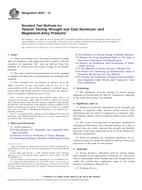Test Method B557
Tension tests provide information on the strength and ductility of materials under uniaxial tensile stresses. This information may be useful in comparisons of materials, alloy development, quality control, and design under certain circumstances. The results of tension tests of specimens machined to standardized dimensions from selected portions of a part or material may not totally represent the strength and ductility properties of the entire end product or its in-service behavior in different environments. Final fantasy 5 snes rom german. These test methods are considered satisfactory for acceptance testing of commercial shipments. The test methods have been used extensively in the trade for this purpose.
Labs use ASTM Test Method B557 to determine tensile strength, yield strength, and elongation. Diablo 2 install disc. Samples ship in February and August.
Scope 1.1 These test methods cover the tension testing of metallic materials in any form at room temperature, specifically, the methods of determination of yield strength, yield point elongation, tensile strength, elongation, and reduction of area. 1.2 The gage lengths for most round specimens are required to be 4D for E8 and 5D for E8M.
The gage length is the most significant difference between E8 and E8M Test Specimens Test specimens made from powder metallurgy (P/M) materials are exempt from this requirement by industry-wide agreement to keep the pressing of the material to a specific projected area and density. 1.3 Exceptions to the provisions of these test methods may need to be made in individual specifications or test methods for a particular material. For examples, see Test Methods and Definitions A370 and Test Methods B557, and B557M. 1.4 Room temperature shall be considered to be 10 to 38°C [50 to 100°F] unless otherwise specified.
Astm Test Method
1.5 The values stated in SI units are to be regarded as separate from inch/pound units. The values stated in each system are not exact equivalents; therefore each system must be used independently of the other. Combining values from the two systems may result in non-conformance with the standard. 1.6 This standard does not purport to address all of the safety concerns, if any, associated with its use. It is the responsibility of the user of this standard to establish appropriate safety and health practices and determine the applicability of regulatory limitations prior to use.
Testing Method

Related news • Jan. 28, 2019 NGVAmerica members Waste Management and UPS announced they earned an ‘A’ grade this year from the environmental non-profit CDP (formerly the Carbon Disclosure Project) for the depth and quality of climate change data it discloses to investors and the global marketplace. CDP’s 2018 Climate A-List places Waste Management and UPS among a competitive group of companies from around the world identified as leaders in their efforts to combat climate change.